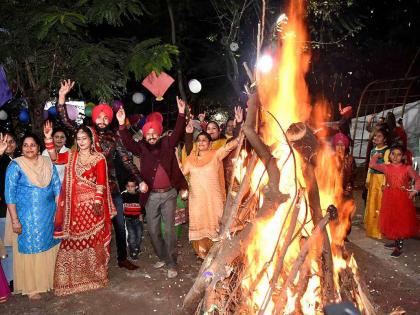Why Is Food Thrown Into Lohri's Fire? Here's All You Need to Know About the Ritual
By Lokmat English Desk | Updated: January 9, 2024 14:01 IST2024-01-09T13:55:06+5:302024-01-09T14:01:31+5:30
Lohri marks the end of the winter. Crowds gather around large, teaming bonfires to celebrate the passing of the ...

Why Is Food Thrown Into Lohri's Fire? Here's All You Need to Know About the Ritual
Lohri marks the end of the winter. Crowds gather around large, teaming bonfires to celebrate the passing of the winter solstice. Rabi crops are primed for harvest as farmers look forward to a new season. Associated with Punjab and some other parts of northern India, this festival marks the end of the winter solstice, and it is believed that worshippers wait for the Sun God to shower them with warmth and light after the cold days. A significant aspect of the celebrations is the bonfire.
Post-sunset celebrations usually involve building a bonfire and then taking turns roaming around it in circles, throwing food items like til, aka sesame seeds, popcorn, and so on into it. You would find people getting warmed up while sitting around a huge bonfire on the evening of Lohri. They’ll be throwing in food too. Have you ever wondered why this is practiced? The practice of throwing food items like peanuts, sesame seeds, jaggery, popcorn, and other offerings into the Lohri bonfire holds symbolic significance. It is believed that by offering these items to the fire, people seek blessings from Agni. They also express gratitude for a bountiful harvest. The act is also seen as a way to welcome good luck into their lives.
Additionally, throwing these food items into the fire is considered a form of reverence and an offering to the natural elements, seeking their favour for the upcoming agricultural season. It’s a way of embracing the cycle of life, from the end of the winter season to the arrival of spring and the planting of new crops. The crackling sound of these items burning also signifies the breaking of the winter spell and the arrival of warmth. People sing traditional Lohri songs like “Sunder Mundriye” and engage in vibrant dances like Bhangra and Gidda around the bonfire. These songs depict the richness of Punjabi culture, narrating tales of folklore and celebrating the spirit of the festival. Families and friends also exchange gifts, sweets, and traditional delicacies like gajak, rewri, peanuts, popcorn, and til (sesame) sweets as a symbol of love and goodwill.